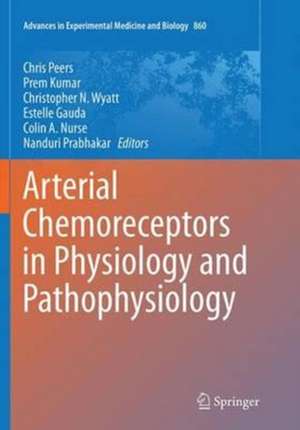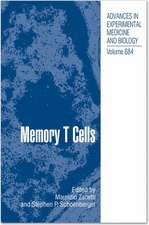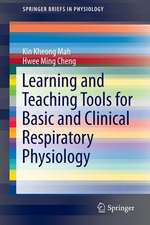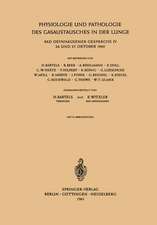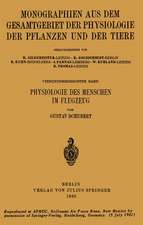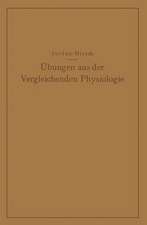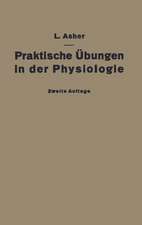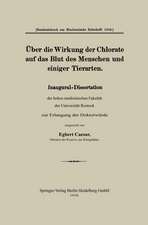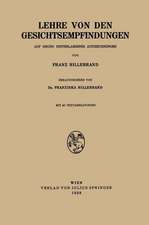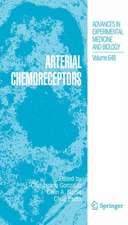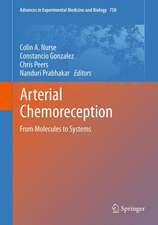Arterial Chemoreceptors in Physiology and Pathophysiology: Advances in Experimental Medicine and Biology, cartea 860
Editat de Chris Peers, Prem Kumar, Christopher Wyatt, Estelle Gauda, Colin A. Nurse, Nanduri Prabhakaren Limba Engleză Paperback – 22 oct 2016
| Toate formatele și edițiile | Preț | Express |
|---|---|---|
| Paperback (1) | 687.10 lei 38-44 zile | |
| Springer International Publishing – 22 oct 2016 | 687.10 lei 38-44 zile | |
| Hardback (1) | 746.99 lei 3-5 săpt. | |
| Springer International Publishing – 11 sep 2015 | 746.99 lei 3-5 săpt. |
Din seria Advances in Experimental Medicine and Biology
- 9%
 Preț: 719.60 lei
Preț: 719.60 lei - 20%
 Preț: 691.93 lei
Preț: 691.93 lei - 5%
 Preț: 717.00 lei
Preț: 717.00 lei - 5%
 Preț: 716.28 lei
Preț: 716.28 lei - 5%
 Preț: 717.20 lei
Preț: 717.20 lei - 15%
 Preț: 640.24 lei
Preț: 640.24 lei - 5%
 Preț: 1113.83 lei
Preț: 1113.83 lei - 5%
 Preț: 715.71 lei
Preț: 715.71 lei - 5%
 Preț: 820.43 lei
Preț: 820.43 lei - 15%
 Preț: 641.38 lei
Preț: 641.38 lei - 5%
 Preț: 716.28 lei
Preț: 716.28 lei - 5%
 Preț: 523.99 lei
Preț: 523.99 lei - 5%
 Preț: 1031.00 lei
Preț: 1031.00 lei - 5%
 Preț: 717.00 lei
Preț: 717.00 lei - 5%
 Preț: 715.35 lei
Preț: 715.35 lei - 20%
 Preț: 1161.71 lei
Preț: 1161.71 lei - 5%
 Preț: 1170.51 lei
Preț: 1170.51 lei - 18%
 Preț: 1119.87 lei
Preț: 1119.87 lei - 5%
 Preț: 1288.48 lei
Preț: 1288.48 lei - 5%
 Preț: 1164.67 lei
Preț: 1164.67 lei - 5%
 Preț: 1101.73 lei
Preț: 1101.73 lei - 18%
 Preț: 1123.67 lei
Preț: 1123.67 lei - 5%
 Preț: 1435.64 lei
Preț: 1435.64 lei - 20%
 Preț: 1044.10 lei
Preț: 1044.10 lei - 18%
 Preț: 946.39 lei
Preț: 946.39 lei - 5%
 Preț: 292.57 lei
Preț: 292.57 lei - 18%
 Preț: 957.62 lei
Preț: 957.62 lei - 18%
 Preț: 1235.76 lei
Preț: 1235.76 lei - 5%
 Preț: 1231.55 lei
Preț: 1231.55 lei - 5%
 Preț: 1292.30 lei
Preț: 1292.30 lei - 5%
 Preț: 1102.10 lei
Preț: 1102.10 lei - 18%
 Preț: 1132.81 lei
Preț: 1132.81 lei - 5%
 Preț: 1165.19 lei
Preț: 1165.19 lei - 5%
 Preț: 1418.48 lei
Preț: 1418.48 lei - 5%
 Preț: 1305.63 lei
Preț: 1305.63 lei - 18%
 Preț: 1417.72 lei
Preț: 1417.72 lei - 18%
 Preț: 1412.99 lei
Preț: 1412.99 lei - 24%
 Preț: 806.16 lei
Preț: 806.16 lei - 18%
 Preț: 1243.29 lei
Preț: 1243.29 lei - 5%
 Preț: 1429.44 lei
Preț: 1429.44 lei - 5%
 Preț: 1618.70 lei
Preț: 1618.70 lei - 5%
 Preț: 1305.12 lei
Preț: 1305.12 lei - 18%
 Preț: 1124.92 lei
Preț: 1124.92 lei - 5%
 Preț: 1097.54 lei
Preț: 1097.54 lei - 15%
 Preț: 649.87 lei
Preț: 649.87 lei - 5%
 Preț: 1097.54 lei
Preț: 1097.54 lei - 18%
 Preț: 945.79 lei
Preț: 945.79 lei - 5%
 Preț: 1123.16 lei
Preț: 1123.16 lei
Preț: 687.10 lei
Preț vechi: 723.26 lei
-5% Nou
Puncte Express: 1031
Preț estimativ în valută:
131.49€ • 142.78$ • 110.45£
131.49€ • 142.78$ • 110.45£
Carte tipărită la comandă
Livrare economică 18-24 aprilie
Preluare comenzi: 021 569.72.76
Specificații
ISBN-13: 9783319349602
ISBN-10: 3319349600
Pagini: 404
Ilustrații: XI, 404 p. 150 illus., 51 illus. in color.
Dimensiuni: 178 x 254 mm
Ediția:Softcover reprint of the original 1st ed. 2015
Editura: Springer International Publishing
Colecția Springer
Seria Advances in Experimental Medicine and Biology
Locul publicării:Cham, Switzerland
ISBN-10: 3319349600
Pagini: 404
Ilustrații: XI, 404 p. 150 illus., 51 illus. in color.
Dimensiuni: 178 x 254 mm
Ediția:Softcover reprint of the original 1st ed. 2015
Editura: Springer International Publishing
Colecția Springer
Seria Advances in Experimental Medicine and Biology
Locul publicării:Cham, Switzerland
Cuprins
Preface.- C Peers & P Kumar.- 2 Epigenetic regulation of Carotid Body Oxygen Sensing: Clinical Implications, J. Nanduri, N. R. Prabhakar.- 3 Experimental observations on the biological significance of hydrogen sulfide in carotid body chemoreception, T.Gallego-Martin, T. Agapito, M. Ramirez, E. Olea, S. Yubero, A. Rocher, A. Gomez-Nino, A. Obeso, C. Gonzalez.- 4 The CamKKβ inhibitor STO609 causes artefacts in calcium imaging and selectively inhibits BKCa in mouse carotid body type I cells.- J. G. Jurcsisn, R. L. Pye, J. Ali, B. L. Barr and C. N. Wyatt.- 5 Tissue dynamics of the carotid body under chronic hypoxia: a computational study, A. Porzionato, D. Guidolin, V. Macchi, G. Sarasin, A. Mazzatenta, C. Di Giulio, J. Lopez-Barneo, R. De Caro.- 6 Paracrine Signaling in Glial-like Type II cells of the Rat Carotid Body, S. Murali, M. Zhang, C. A. Nurse.- 7 Selective μ and κ opioid agonists inhibit voltage-gated Ca2+ entry in isolated rat carotid body type I cells, E. M. Ricker, R. L. Pye, B. L. Barr, C. N. Wyatt.- 8 Measurement of ROS levels and membrane potential dynamics in the intact carotid body ex vivo, A. Bernardini, U. Brockmeier, E. Metzen, U. Berchner-Pfannschmidt, E. Harde, A. Acker-Palmer, D. Papkovsky, H. Acker, J. Fandrey.- 9 Acutely administered leptin increases [Ca2+]i and changes membrane conductance via modulation of BKCa channels in rat carotid body type I cells, R.L. Pye, E.J. Dunn, E.M. Ricker, B.L. Barr, C.N. Wyatt .- 10 Functional properties of mitochondria in the type-1 cell and their role in oxygen sensing, K.J. Buckler & P.J. Turner.- 11 Potentiation of hypoxic pulmonary vasoconstriction by hydrogen sulfide precursors 3-mercaptopyruvate and D-cysteine is blocked by the cystathione g lyase inhibitor propargylglycine, J. Prieto-Lloret & P. I. Aaronson.- 12 Modulation of the LKB1-AMPKsignalling pathway underpins hypoxic pulmonary vasoconstriction and pulmonary hypertension, A.M. Evans, S.A. Lewis, O.A. Ogunbayo, J. Moral-Sanz.- 13 Organismal Responses to Hypoxemic Challenges, R.S. Fitzgerald, G.A. Dehghani, S. Kiihl.- 14 Effect of lipopolysacchride (LPS) exposure on structure and function of the carotid body in newborn rats, Z.R. Master, K. Kesavan, A. Mason, M. Shirahata, E.B. Gauda.- 15 Hypoxic Ventilatory Reactivity in Experimental Diabetes, M. Pokorski, M. Pozdzik, J. Antosiewicz, A. Dymecka, A. Mazzatenta, C. Di Giulio.- 16 Adenosine receptor blockade by caffeine inhibits carotid sinus nerve chemosensory activity in chronic intermittent hypoxic animals, J.F. Sacramento, C. Gonzalez, M.C. Gonzalez-Martin and S.V. Conde.- 17 Neurotrophic properties, chemosensory responses and neurogenic niche of the human carotid body, P Ortega-Sáenz, J Villadiego, R Pardal, JJ Toledo-Aral and J López-Barneo.- 18 Is the carotid body a metabolic monitor?, M. Shirahata, W-Y Tang, M.-K. Shin, V. Polotsky.- 19 Lipopolysaccharide-induced ionized hypocalcemia and acute kidney injury in carotid chemo/baro-denervated rats, R. Fernandez, P. Cortes, R. del Rio, C. Acuna-Castillo, E.P. Reyes.- 20 Role of the Carotid Body Chemoreflex in the Pathophysiology of Heart Failure: A Perspective from Animal Studies, H.D. Schultz, N. J. Marcus & R. Del Rio.- 21 A short-term fasting in neonates induces breathing instability and epigenetic modification in the carotid body, W.-Y. Tang, E. Kostuk, M. Shirahata.- 22 Carotid Body Chemoreflex Mediates Intermittent Hypoxia-Induced Oxidative Stress in the Adrenal Medulla, G.K. Kumar, Y-J. Peng, J. Nanduri, N.R. Prabhakar.- 23 The association between antihypertensive medication and blood pressure control in patients with obstructive sleep apnea, L.N. Diogo, P. Pinto, C. Bárbara, A.L. Papoila, E.C. Monteiro.- 24 An overview on therespiratory stimulant effects of caffeine and progesterone on response to hypoxia and apnea frequency in developing rats, A. Bairam, N.P. Uppari, S. Mubayed, V. Joseph.- 25 Hyperbaric oxygen therapy improves glucose homeostasis in type 2 diabetes patients: a likely involvement of the carotid bodies, P. Vera-Cruz, F. Guerreiro, M.J. Ribeiro, M.P. Guarino, S.V. Conde.- 26 Possible role of TRP channels in rat glomus cells, I. Kim, L. Fite, D. F. Donnelly, J. H. Kim, J. L. Carroll.- 27 Nitric oxide deficit is part of the maladaptive paracrine-autocrine response of the carotid body to intermittent hypoxia in sleep apnea, M.L. Fung.- 28 Respiratory control in the mdx mouse model of Duchenne muscular dystrophy , D. Burns, D. Edge, D. O’Malley, K.D. O’Halloran.- 29 Mild chronic intermittent hypoxia in Wistar rats evokes significant cardiovascular pathophysiology but no overt changes in carotid body-mediated respiratory responses, C. J. Ray, B. Dow, P. Kumar, A.M. Coney.- 30 Crucial role of the carotid body chemoreceptors on the development of high arterial blood pressure during chronic intermittent hypoxia, R. Iturriaga, D.C. Andrade, R. Del Rio.- 31 Relative contribution of nuclear and membrane progesterone receptors in respiratory control, R. Boukari, F. Marcouiller, V. Joseph.- 32 Inhibition of protein kinases AKT and ERK1/2 reduce the carotid body chemoreceptor response to hypoxia in adult rats, J. P. Iturri, V. Joseph, G. Rodrigo, A. Bairam, J. Soliz.- 33 Ecto-5’-nucleotidase, adenosine and transmembrane adenylyl cyclase signalling regulate basal carotid body chemoafferent outflow and establish the sensitivity to hypercapnia, A.P.S. Holmes, A.R. Nunes, M.J. Cann, P.Kumar.- 34 T-type Ca2+ channel regulation by CO: a mechanism for control of cell proliferation, H. Duckles, M.M. Al-Owais, J. Elies, E. Johnson, H.E. Boycott, M.L. Dallas, K.E. Porter, J.P. Boyle, J. L. Scragg, C.Peers.- 35 Glutamatergic Receptor Activation in the Commisural Nucleus Tractus Solitarii (cNTS) Mediates Brain Glucose Retention (BGR) Response to Anoxic Carotid Chemoreceptor (CChr) Stimulation in Rats, R. Cuellar, S. Montero, S. Luquin, J. Garcia-Estrada, O. Dobrovinskaya, V. Melnikov, M. Lemus, E. Roces de Alvarez-Buyll.- 36 Enhanced Serotonin (5HT) secretion in pulmonary neuroepithelial bodies from PHD-1 null mice, S. Livermore, J. Pan, H. Yeger, P. Ratcliffe, T. Bishop, E. Cutz.- 37 Selective expression of galanin in type I cells of the human carotid body, C. Di Giulio, G.D. Marconi, S. Zara, A. Di Tano, A. Porzionato, M. Pokorski, A. Cataldi, V. Macchi , A.Mazzatenta.- 38 Role of BK channels in murine carotid body neural responses in vivo, L.E. Pichard, C.M. Crainiceanu, P. Pashai, E.W. Kostuk, A. Fujioka, M. Shirahata.- 39 Chronic intermittent hypoxia blunts the expression of ventilatory long term facilitation in sleeping rats, D. Edge, KD. O’Halloran.- 40 Heme oxygenase-1 influences apoptosis via CO-mediated inhibition of K+ channels, M.M. Al-Owais, M.L. Dallas, J.P. Boyle, J. L. Scragg , C. Peers.- 41 Inhibition of T-type Ca2+ channels by hydrogen sulphide, J. Elies, JL Scragg, M. Dallas, D. Huang, S. Huang, JP Boyle, N. Gamper, C. Peers.- 42 GAL-021 and GAL-160 are efficacious in rat models of obstructive and central sleep apnea and inhibit BKCa in isolated rat carotid body glomus cells, M. Dallas, C. Peers, F.J. Golder, S. Baby, R. Grube, D.E. MacIntyre.- 43 The human carotid body gene expression and function in signaling of hypoxia and inflammation, J. Kåhlin, S. Mkrtchian, A. Ebberyd, L. I. Eriksson, M. J. Fagerlund.- 44 The Carotid Body Does Not Mediate The Acute Ventilatory Effects Of Leptin, E. Olea, M.J. Ribeiro, T.Gallego-Martin, S. Yubero, R. Rigual, JF. Masa, A. Obeso, S. V. Conde, C. Gonzalez.- 45 Concluding Remarks, E. Gauda.-Index
Textul de pe ultima copertă
Every three years, the International Society for Arterial Chemoreception (ISAC) arranges a Meeting to bring together all of the major International research groups investigating the general topic of oxygen sensing in health and disease, with a prime focus upon systemic level hypoxia and carotid body function. This volume summarises the proceedings of the XIXth meeting of the Society, held in Leeds, UK during the summer of 2014. As such this volume represents a unique collection of state of the art reviews and original, brief research articles covering all aspects of oxygen sensing, ranging from the molecular mechanisms of chemotransduction in oxygen sensing cells such as the carotid body type I cells, to the adverse, reflex cardiovascular outcomes arising from carotid body dysfunction as seen, for example, in heart failure or obstructive sleep apnoea. This volume will be of tremendous interest to basic scientists with an interest in the cellular and molecular biology of oxygen sensing and integrative, whole organism physiologists as well as physicians studying or treating the clinical cardiovascular consequences of carotid body dysfunction.
Caracteristici
The book features state of the art research articles from researchers who are leading authorities in the field The book contains selected reviews from plenary lectures invited to the associated meeting The book will be a comprehensive reference for anyone interested in chemoreception and its influence on cardiorespiratory diseases
